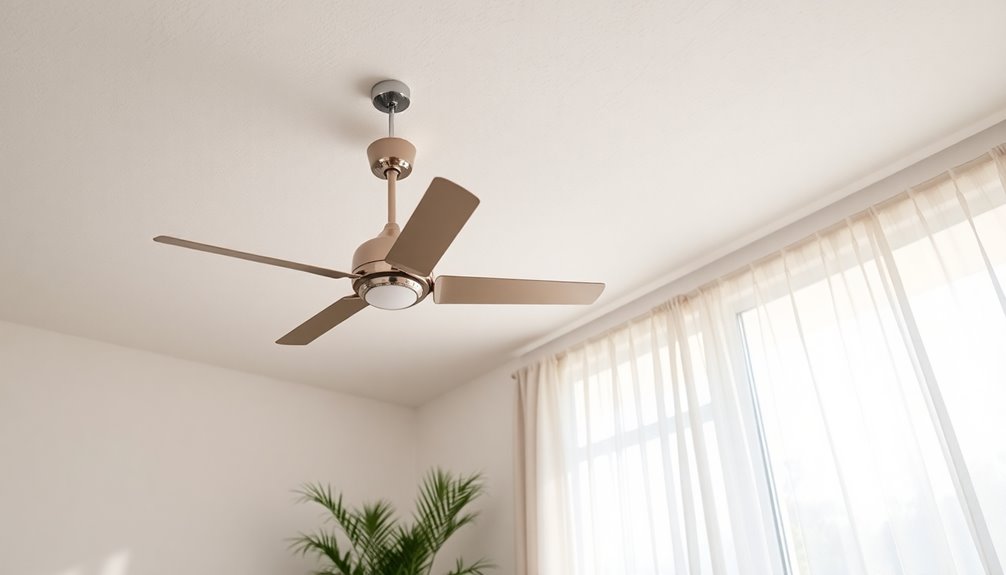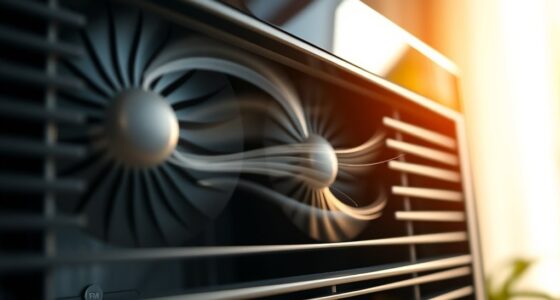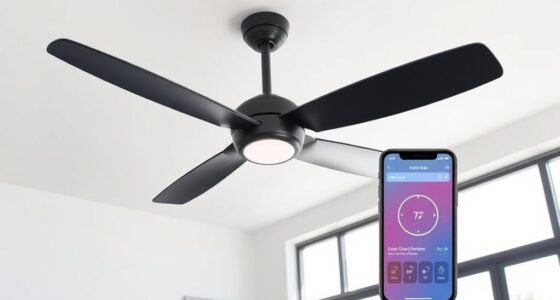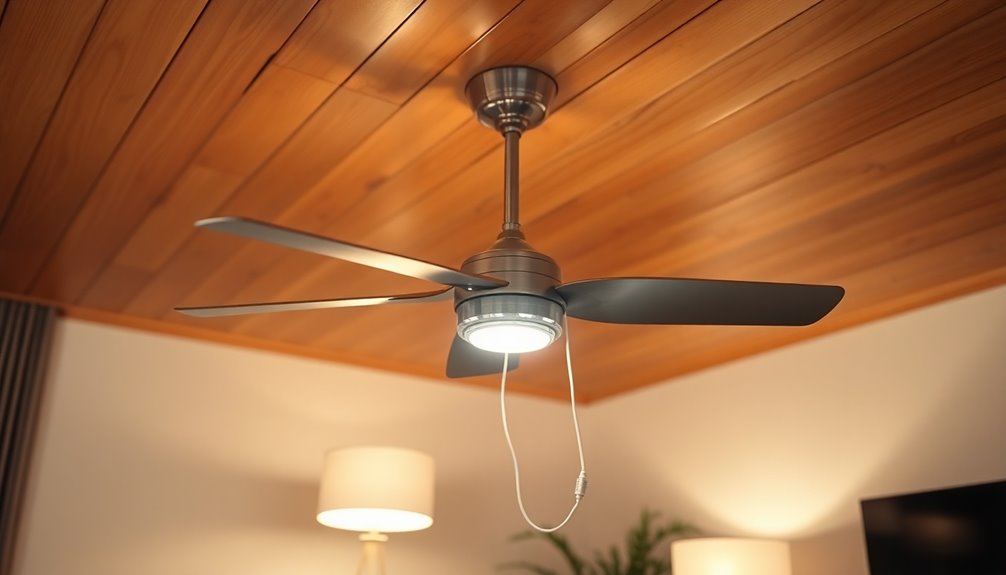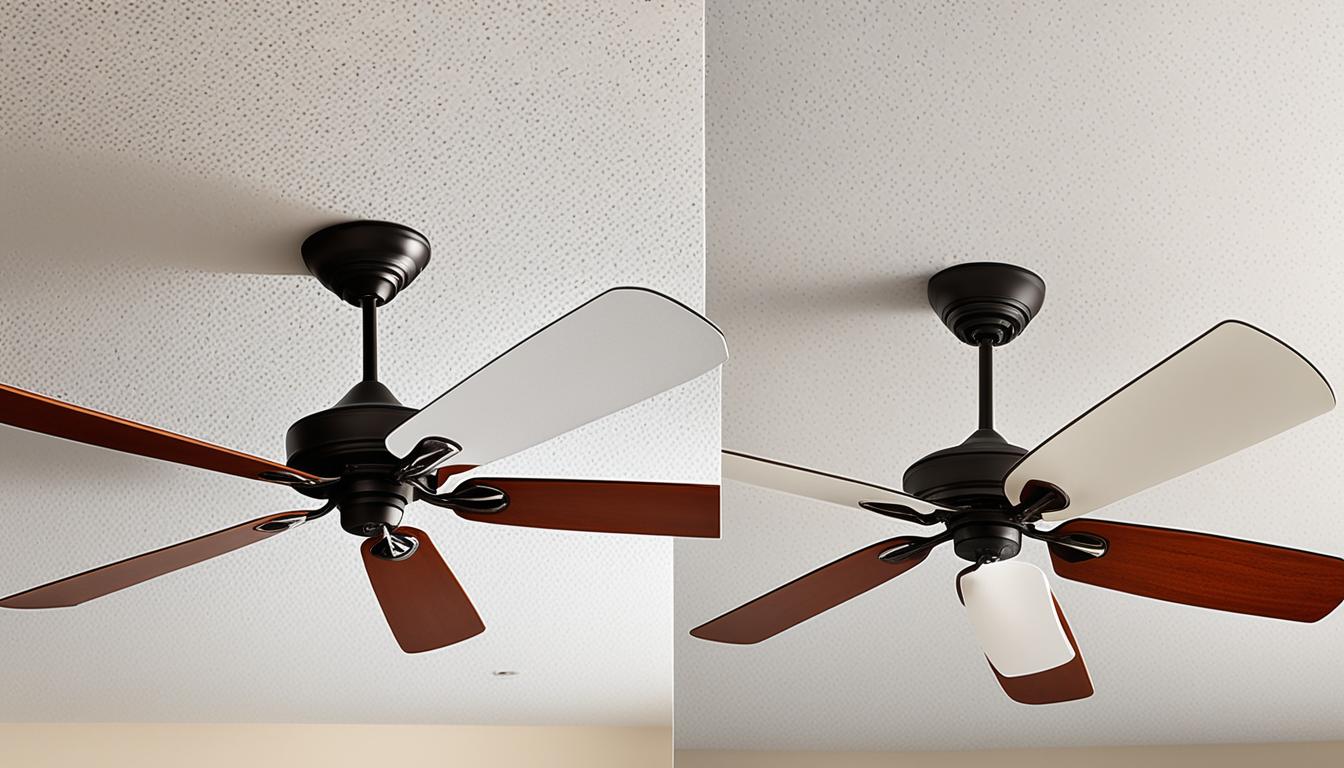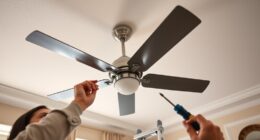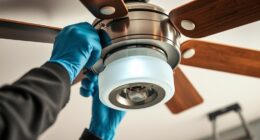To blow air down and cool your space, your ceiling fan should spin counterclockwise during the summer. This rotation creates a downdraft, pushing cool air straight toward you and producing a revitalizing breeze. You'll notice a more comfortable environment, which can even help you raise your thermostat setting without feeling warmer. To check if your fan is turning the right way, stand directly beneath it and feel for a cool breeze. If you want to know more about how to adjust your fan or switch it for winter use, keep going to uncover essential tips!
Key Takeaways
- A ceiling fan turns counterclockwise to blow air down, creating a cooling downdraft.
- This counterclockwise rotation enhances the wind chill effect for increased comfort.
- Higher speed settings during counterclockwise operation improve airflow effectiveness.
- You can confirm the direction by checking for a cool breeze directly beneath the fan.
- Adjusting to counterclockwise in summer allows for higher thermostat settings without discomfort.
Benefits of Ceiling Fans

Enjoying a comfortable indoor environment is made easier with ceiling fans, which effectively disperse air and enhance the distribution of your air conditioning.
By setting your ceiling fan to turn counterclockwise in summer, you create a downdraft that helps circulate the air, making you feel cooler without overworking your AC unit. This simple adjustment can greatly reduce your air conditioning costs, as you rely less on cooling systems during those hot months.
In winter, reversing the ceiling fan direction to rotate clockwise allows it to circulate warm air that rises to the ceiling, ensuring even heat distribution throughout the room.
This not only enhances comfort but also leads to energy savings, as you won't need to activate your heating systems as frequently.
Summer Fan Direction

When summer heat hits, adjusting your ceiling fan to spin counterclockwise can make a significant difference in your comfort level. This ceiling fan direction creates a downdraft, pushing cool air directly downward.
You'll enjoy a revitalizing wind chill effect that makes the room feel cooler, even though the fan doesn't actually lower the air temperature.
To maximize the cooling sensation, run the fan at higher speed settings. This increases airflow effectiveness, enhancing your comfort throughout the summer.
By using the fan correctly, you can even raise your thermostat setting by about 4 degrees without sacrificing comfort, leading to energy savings on your utility bill.
To verify your fan is spinning counterclockwise, stand directly beneath it and check for a cool breeze. If you feel a weak airflow, you'll need to adjust the fan.
Winter Fan Direction

To stay cozy during the winter months, it's crucial to set your ceiling fan to rotate clockwise. This ceiling fan switch helps circulate warm air that tends to accumulate near the ceiling.
When you adjust the fan direction to clockwise, it creates a gentle updraft that mixes the cooler air below with the warm air above without causing any cold drafts.
Running your ceiling fan at a low speed during winter is key. This allows for effective heat distribution while avoiding direct drafts that can be uncomfortable.
In your dining room, for example, setting the fan to a medium or low clockwise speed helps maintain warmth without rapidly cooling your food.
Seasonal Direction Changes

Adjusting your ceiling fan direction with the changing seasons can greatly enhance your comfort and energy efficiency. During summer, you'll want your ceiling fans to turn counterclockwise. This creates a downdraft that delivers cool air right where you need it. When you're sleeping, this rotation helps lower the perceived temperature, ensuring you stay comfortable all night long.
As the seasons change, don't forget to switch it up! In the cooler months, a clockwise rotation at a medium or low fan speed gently circulates air without strong drafts. This is perfect for cozy indoor meals, maintaining a pleasant atmosphere without overwhelming gusts. For larger spaces, clockwise rotation also improves overall air circulation, enhancing your comfort level.
Here's a quick overview of seasonal direction changes:
| Season | Fan Direction |
|---|---|
| Summer | Counterclockwise |
| Winter | Clockwise |
| Sleeping | Counterclockwise |
| Dining | Clockwise |
Methods to Change Direction

Changing your ceiling fan's direction is a straightforward process that can enhance your comfort throughout the year.
By adjusting the direction, you can optimize airflow, making your living space feel just right. Here are three methods to change the direction of your ceiling fan:
1. Pull Chain Fans: Turn off the fan for safety.
Locate the fan switch on the body and slide it to change the direction.
When the fan starts again, it should spin counterclockwise to blow air down in summer or turn clockwise for a warm breeze in winter.
2. Remote-Controlled Fans: Verify the fan is off.
Press and hold the fan button on the remote until the light blinks, indicating the direction has changed.
This will allow you to easily turn the fan without getting up.
3. Smart Fans: Using the SIMPLEconnect app or a voice command, turn the fan off before making any adjustments.
This tech-savvy option can help you keep up with seasonal changes effortlessly.
Regularly check the fan's direction during seasonal changes to maximize comfort.
A properly adjusted fan can make a significant difference in your home's ambiance.
Frequently Asked Questions
Which Way Does a Ceiling Fan Turn to Push Air Down?
When you're trying to cool down a room, the direction of your ceiling fan matters.
If you want to push air down and create a revitalizing breeze, you'll need the fan to spin counterclockwise. This rotation directs the cool air straight toward you, enhancing your comfort.
To check if it's working properly, stand underneath and feel for a strong airflow. If it's weak, just flip the switch to adjust the direction.
How Do You Tell if a Fan Is Going Clockwise or Counterclockwise?
As you stand beneath the fan, imagine the blades slicing through the air, casting shadows on the ceiling.
If they glide to the right, you're witnessing a clockwise spin; if they sweep to the left, it's counterclockwise.
Feel the air: a cool breeze means it's spinning counterclockwise, while stillness indicates clockwise.
Don't forget to flip the switch or use the remote to change directions easily whenever you need a different airflow!
How Do I Know if My Fan Is Blowing Air up or Down?
To check if your fan's blowing air up or down, stand directly beneath it and feel for a breeze.
If you sense a noticeable airflow on your skin, the fan's blowing air down, creating a cooling effect. If there's little to no airflow, it's likely pushing air upward.
Remember, it's important to turn off the fan before making any adjustments to its direction for safety.
This simple method helps you maximize your comfort.
Which Way Should a Ceiling Fan Go for an Updraft?
Picture your ceiling fan as a gentle breeze whispering warmth through your home.
To create an updraft, you should set your fan to rotate clockwise. This motion pulls cooler air up, allowing the warm air that gathers near the ceiling to circulate back down into your living space.
Running it at low speed keeps things cozy without creating a draft, helping you stay comfortable and potentially saving you money on heating bills.
Conclusion
To sum up, understanding how a ceiling fan turns can enhance your comfort all year round. During summer, you want it to spin counterclockwise to push cool air down, while in winter, a clockwise direction helps circulate warm air. Curiously, many believe that reversing the fan's direction saves energy, but studies suggest the real savings come from using it to complement your heating and cooling systems. So, don't overlook this simple adjustment—it can make a real difference!

